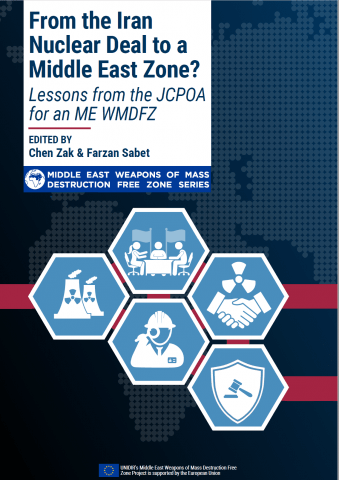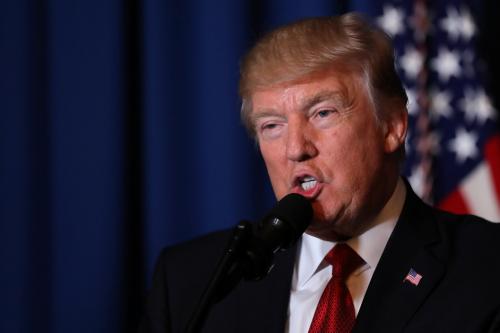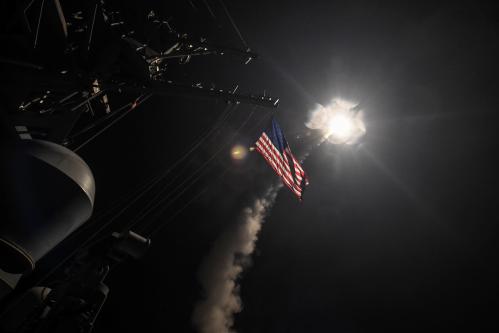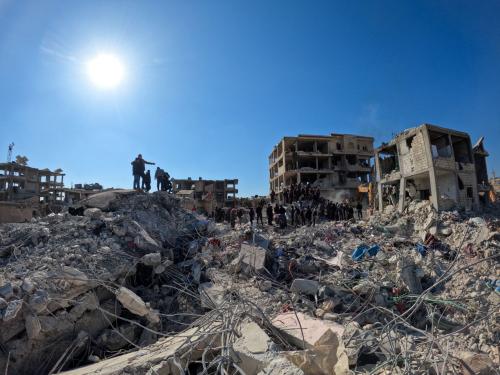America’s traditional Middle Eastern allies—especially Israel and Saudi Arabia—greeted the surprise victory of Donald Trump in 2016 with glee. His main qualification: He seemed to be the opposite of Barack Obama, especially with regard to Iran and to Syria. In their eyes, Obama’s sins were many, but none were greater than the negotiation and signing of the Joint Comprehensive Plan of Action (JCPOA) with Iran, and the failure to uphold his own red line in Syria, letting President Bashar Assad’s use of chemical weapons go unanswered.
In Trump, these allies do—ostensibly—have the opposite of Obama: Trump is contemplating abrogating the JCPOA, facing a deadline on sanction waivers in May; and he seems poised to, once again, bomb Syria for the Assad’s regime use of chemical weapons. On Wednesday he tweeted:
Russia vows to shoot down any and all missiles fired at Syria. Get ready Russia, because they will be coming, nice and new and “smart!” You shouldn’t be partners with a Gas Killing Animal who kills his people and enjoys it!
— Donald J. Trump (@realDonaldTrump) April 11, 2018
This threat of force comes against the backdrop of a potentially far more important move on Syria. Trump has recently instructed the military to plan for a withdrawal of U.S. troops from the country, even before the fight against ISIS there is complete. Beneath the surface, Trump is not Obama’s opposite on the Middle East; in some ways, he’s a more extreme version of Obama, and the allies are noticing.
The Israeli and Saudi reaction to the JCPOA and the long negotiations that preceded it were not just about what they saw as nuclear risk, not just a “bad deal” in their eyes. The responses reflected a sense of betrayal: the feeling that the United States, their closest ally, was now making nice with their mortal enemy. Some U.S. critics saw Obama flipping sides in the Middle East altogether, courting Iranian friendship. As I wrote in 2016, I don’t think Obama was flipping sides, “he was doing something conceptually more radical. He questioned the need to choose sides at all.” Obama seemed aloof to Middle Eastern quarrels, and nothing can anger a partisan more than an aloof friend, staying above the fray and refusing to join the fight.
More fundamentally still, the Obama administration was seeking to decrease U.S. investment in the region, to rebalance toward Asia, and to eschew the role of active regional policeman. Obama did not wish to be, and was not elected to be, another George W. Bush, sending U.S. soldiers into harm’s way for a region in seemingly interminable conflict. His failure to uphold the red line in Syria was, many in the region thought, part and parcel of an abandonment of the U.S. hegemonic role, which allowed Russia to re-enter the Middle East as a major external player. Where Washington wanted to rebalance away, the Middle Eastern allies were clamoring for it to stay. Notwithstanding the fact that the United States remained heavily involved in the region, something fundamental did indeed shift in the regional order and the U.S. role in it.
In this sense, Trump is Obama in hyper drive. While he is anything but aloof, and indeed keen to pick sides—showering love on Saudi Arabia and Israel—his instinct on the Middle East is clear: He wants no part of that mess. In February, among many other instances, he tweeted the sentiment:
This will be a big week for Infrastructure. After so stupidly spending $7 trillion in the Middle East, it is now time to start investing in OUR Country!
— Donald J. Trump (@realDonaldTrump) February 12, 2018
Already among allies, notably Israel, there is deep concern over a potential U.S. withdrawal and over the U.S. strategy writ large. Israeli press reported a “tense conversation” between Trump and Israeli Prime Minister Benjamin Netanyahu in recent days over Syria. While some in the Israeli security establishment are happy that Trump might walk away from the JCPOA, some privately voice concern that there’s no apparent strategy for what follows. With the JCPOA gone, does the United States have a plan for pushing back against Iranian regional activity, not least in Syria? A U.S. withdrawal would suggest the opposite: a desire to disengage further.
The results can be seen in the tangible actions of allies. This week, someone bombed an Iranian post in a Syrian air base—everyone suspects Israel, and it has done little to disavow them of that suspicion. This base housed the command post for an Iranian drone that was launched into Israeli air space in February, followed by an exchange of fire that downed an Israeli jet. This was not a random skirmish or a fleeting flare-up: Iran is among the victors in the Syrian civil war and it intends to gain more presence in the country; Israel has made clear it will do all it can to stop that from happening. Israel and Iran are now in open confrontation in Syria.
In the past, allies would call 1600 Pennsylvania Avenue first with such fundamental concerns, and U.S. leadership was seen as essential to the overall architecture of the region. If Iran were entrenching itself in Syria, it would have been a U.S. problem, even if previous administrations often fell short of actually solving such problems. For many American voters—and, to differing degrees, for the last two U.S. presidents as well—that was not necessarily a good thing. For U.S. allies, the alternative seems far worse.
The Brookings Institution is committed to quality, independence, and impact.
We are supported by a diverse array of funders. In line with our values and policies, each Brookings publication represents the sole views of its author(s).











Commentary
Israel and Trump are at odds on Syria
April 11, 2018